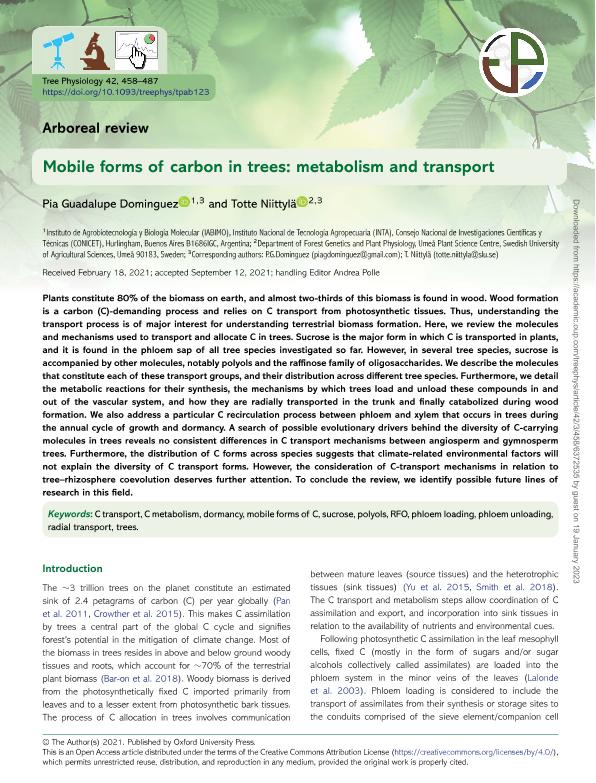Mostrar el registro sencillo del ítem
dc.contributor.author
Dominguez, Pia Guadalupe

dc.contributor.author
Niittylä, Totte
dc.date.available
2023-01-19T12:27:35Z
dc.date.issued
2021-09
dc.identifier.citation
Dominguez, Pia Guadalupe; Niittylä, Totte; Mobile forms of carbon in trees: metabolism and transport; Oxford University Press; Tree Physiology; 42; 3; 9-2021; 458-487
dc.identifier.uri
http://hdl.handle.net/11336/184986
dc.description.abstract
Plants constitute 80% of the biomass on earth, and almost two-thirds of this biomass is found in wood. Wood formation is a carbon (C)-demanding process and relies on C transport from photosynthetic tissues. Thus, understanding the transport process is of major interest for understanding terrestrial biomass formation. Here, we review the molecules and mechanisms used to transport and allocate C in trees. Sucrose is the major form in which C is transported in plants, and it is found in the phloem sap of all tree species investigated so far. However, in several tree species, sucrose is accompanied by other molecules, notably polyols and the raffinose family of oligosaccharides. We describe the molecules that constitute each of these transport groups, and their distribution across different tree species. Furthermore, we detail the metabolic reactions for their synthesis, the mechanisms by which trees load and unload these compounds in and out of the vascular system, and how they are radially transported in the trunk and finally catabolized during wood formation. We also address a particular C recirculation process between phloem and xylem that occurs in trees during the annual cycle of growth and dormancy. A search of possible evolutionary drivers behind the diversity of C-carrying molecules in trees reveals no consistent differences in C transport mechanisms between angiosperm and gymnosperm trees. Furthermore, the distribution of C forms across species suggests that climate-related environmental factors will not explain the diversity of C transport forms. However, the consideration of C-transport mechanisms in relation to tree-rhizosphere coevolution deserves further attention. To conclude the review, we identify possible future lines of research in this field.
dc.format
application/pdf
dc.language.iso
eng
dc.publisher
Oxford University Press

dc.rights
info:eu-repo/semantics/openAccess
dc.rights.uri
https://creativecommons.org/licenses/by/2.5/ar/
dc.subject
C METABOLISM
dc.subject
C TRANSPORT
dc.subject
DORMANCY
dc.subject
MOBILE FORMS OF C
dc.subject
PHLOEM LOADING
dc.subject
PHLOEM UNLOADING
dc.subject
POLYOLS
dc.subject
RADIAL TRANSPORT
dc.subject
RFO
dc.subject
SUCROSE
dc.subject
TREES
dc.subject.classification
Otras Agricultura, Silvicultura y Pesca

dc.subject.classification
Agricultura, Silvicultura y Pesca

dc.subject.classification
CIENCIAS AGRÍCOLAS

dc.title
Mobile forms of carbon in trees: metabolism and transport
dc.type
info:eu-repo/semantics/article
dc.type
info:ar-repo/semantics/artículo
dc.type
info:eu-repo/semantics/publishedVersion
dc.date.updated
2022-09-21T11:21:38Z
dc.identifier.eissn
1758-4469
dc.journal.volume
42
dc.journal.number
3
dc.journal.pagination
458-487
dc.journal.pais
Reino Unido

dc.journal.ciudad
Oxford
dc.description.fil
Fil: Dominguez, Pia Guadalupe. Instituto Nacional de Tecnología Agropecuaria. Centro de Investigación En Ciencias Veterinarias y Agronómicas. Instituto de Agrobiotecnología y Biología Molecular. Consejo Nacional de Investigaciones Científicas y Técnicas. Oficina de Coordinación Administrativa Parque Centenario. Instituto de Agrobiotecnología y Biología Molecular; Argentina
dc.description.fil
Fil: Niittylä, Totte. Swedish University of Agricultural Sciences; Suecia
dc.journal.title
Tree Physiology
dc.relation.alternativeid
info:eu-repo/semantics/altIdentifier/url/https://academic.oup.com/treephys/article/42/3/458/6372535
dc.relation.alternativeid
info:eu-repo/semantics/altIdentifier/doi/http://dx.doi.org/10.1093/treephys/tpab123
Archivos asociados
